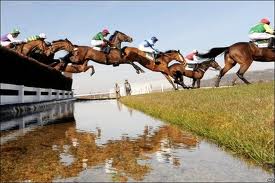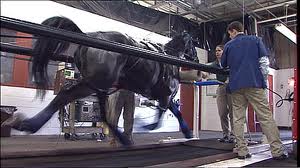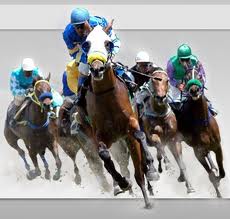|
Horse conditioning program enhances the psychological and the physical responses to exerciseHorse Conditioning
Basic conditioning of the equine athlete involves consideration of the event in which the horse will be competing, the level of competition that you expect the horse to achieve, the time you have in which to condition the horse, and the horse's previous conditioning for the event.

The goal of any basic horse conditioning program is to enhance the psychological and the physical responses to exercise. Psychological responses with conditioning include greater confidence and desire to perform and minimized boredom and resentment. Physical responses include greater strength and endurance, enhanced skills (such as jumping and reining), and minimized soreness or injury due to exercise. Some of the most important physical adaptations achieved by conditioning involve:
•Respiratory System —- increased oxygen uptake, decreased ventilation during exercise
•Cardiovascular System —- lower heart rate during exercise, increased heart size/strength, increased vascularity (decreased resistance), increased total red cell volume (increased oxygen-carrying capacity of the blood)
•Muscular Anatomy —- increased aerobic capacity (increased fast twitch high oxidative fibers = more time before lactic acid accumulation and fatigue during endurance events), increase in muscle size/strength, change in fiber type
•Tendons and Ligaments —- strength and quality may be affected
•Bone —- decreased bone turnover, increased quantity, quality, and geometry of bone in response to training
•Thermoregulation —- involves cardiovascular system.
Slow-speed long distance conditioning, or endurance training is used in the first weeks of all horse conditioning programs and may include breaking. This method usually proceeds fast exercise in some conditioning programs, such as racehorse training. It includes sessions of trotting and cantering at slow speeds for long distances to promote aerobic production of ATP (adenosine triphosphate) for energy. Trainers usually start the horses off slowly and gradually increase the distance at two-to-three week intervals. The total length of time a horse remains on this conditioning program varies with the type of event and can be anywhere from four to five weeks (racehorses) to nine months (endurance horses). Improvements in aerobic capacity, limb strength, and adaptation of skeletal muscle have been seen with slow-speed conditioning.
High-speed conditioning is used to improve the anaerobic capacity of a horse and is generally interspersed with slow-speed, long distance days. This conditioning method varies with the horse and the event. Some trainers increase the speed for very short distances until near maximum speed is reached, then increase the distance. Others establish a set distance and gradually increase the speed. The frequency of the high-speed days varies with the horse conditioning method used. For example, in North America, trainers will commonly use "breeze" (fast galloping for short distances) work at 75 percent of the maximum speed of the event one time every seven to 10 days. Other trainers will gallop their horses at near maximum event speed one time every five days.

The common goal of high-speed conditioning is to increase the amount of training that stimulates anaerobic production of ATP without causing fatigue or overtraining. It is thought that conditioning at maximum event speed may overwork a horse; therefore, most trainers condition their horses at 70 to 85 percent maximum event speed. In England, horses work on a rotational conditioning schedule of hills and flat ground. Using a treadmill with a 5 to 10 percent incline will also increase the anaerobic capacity of a horse without galloping at maximum speed. The physiological adaptations to high-speed conditioning include an increase in Type II muscle fibers.
Interval Horse Training is the use of multiple workouts on the same day separated by short rest periods. Some trainers will use this conditioning method as the horse’s high-speed program. Limited research has shown that interval training may alter muscle fiber type, something that has not been shown to occur with strictly high-speed conditioning. Interval conditioning of the equine athlete should not be performed at 95 to 100 percent maximum speed, as it may lead to overtraining and possibly the reversal of physiological training adaptations.
Return from Horse Conditioning to Horse Riding Connection
|
 A horse conditioning program should be specific to the event in order to train appropriately for the type of exercise in the event. For example, Thoroughbred trainers would not want to strictly use an aerobic conditioning program for their 3-year-old Thoroughbreds because racing is mostly an anaerobic event. There are two general classes of conditioning programs: slow speed and high speed.
A horse conditioning program should be specific to the event in order to train appropriately for the type of exercise in the event. For example, Thoroughbred trainers would not want to strictly use an aerobic conditioning program for their 3-year-old Thoroughbreds because racing is mostly an anaerobic event. There are two general classes of conditioning programs: slow speed and high speed. 